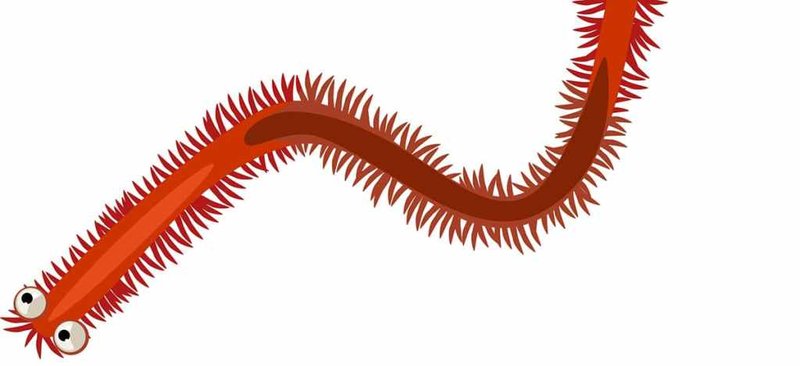
Let’s break it down together. In the vast underwater world, the difference between these two kinds of worms can be a bit like figuring out if you’re petting a friendly dog or a cat that’s just not in the mood. Both might look somewhat similar, but knowing which one you’re dealing with can save you some grief (and maybe even some pain)! So, grab a cup of coffee, and let’s uncover the fascinating traits of fireworms and bristle worms.
What Are Fireworms?
Fireworms belong to the family Amphinomidae, and their bright colors often attract the eye. These worms are usually reddish-brown or orange and can grow up to 10 inches long. But don’t let their stunning appearance fool you! Fireworms have a reputation for being a little aggressive. Their bristles, or chaetae, which might seem like fine hair, actually contain irritants. If you touch them, you could end up with a painful sting, much like brushing against a cactus.
Fireworms are often found in warmer waters, lurking in coral reefs or under rocks. They live in a variety of environments and play a significant role in the ecosystem by feeding on decomposing materials, dead coral, and algae. However, despite their important role in marine ecosystems, it’s best to keep your distance if you encounter one while snorkeling or diving.
How to Identify Fireworms
Identifying a fireworm isn’t just about looking at its colors. Here are a few key traits to keep in mind:
- Color: Look for reddish-brown or orange hues, which can help you spot them easily.
- Size: Fireworms can reach lengths of 3 to 10 inches, depending on the species.
- Bristles: Check if they have long, hair-like bristles along their body. If you see these, it’s time to back away!
If you find a worm matching these characteristics, it’s likely a fireworm. Remember, the best rule is to admire them from a distance!
What Are Harmless Bristle Worms?
On the flip side, we have our friendlier counterpart—the bristle worm. Typically part of the family Polychaeta, these worms come in a variety of shapes and colors, but many tend to be more muted compared to their fiery cousins. Most bristle worms are harmless and can even be beneficial. They help aerate the sand and break down organic material, similar to how earthworms work in gardens.
Bristle worms range in size from a couple of inches to more than a foot long. While they do have bristles, these are often not as irritative as those of fireworms. Instead of causing pain, they’re more likely to be a sign of a healthy marine environment.
How to Identify Harmless Bristle Worms
Identifying harmless bristle worms is a bit of a balancing act. Here are some features that distinguish them from fireworms:
- Color: They can be a range of colors, but they mostly sport dull browns, greens, or even beige, making them less flashy than fireworms.
- Size: Many are shorter, usually coming in under 6 inches, but some can grow larger.
- Bristles: Their bristles are often shorter and not as prominent as those of fireworms, making them look more like tiny fuzzy hairs than dangerous spikes.
If you’re unsure, remember that a little caution goes a long way. Admiring these worms without touching is always a good practice.
Why It Matters: The Ecological Role of These Worms
Understanding the differences between fireworms and bristle worms is more than just an academic exercise; it has real implications for marine ecosystems. Both types of worms play essential roles. Fireworms contribute to the recycling of nutrients in coral reefs by consuming organic material. This helps maintain a balance within the ecosystem, ensuring healthy marine life.
On the other hand, bristle worms are vital for a healthy seafloor. They aerate sediments, allowing oxygen and nutrients to circulate. This promotes a thriving environment for other beneficial creatures, like crabs and various shellfish. Recognizing which worm is which can help you appreciate the complexity and interdependence of marine life.
Potential Risks of Fireworm Exposure
If you accidentally come into contact with a fireworm, it can be uncomfortable. The irritants in their bristles can cause skin reactions similar to a jellyfish sting. Symptoms might include:
- Redness at the site of contact
- Itching or burning sensations
- Swelling in some cases
If you do get stung, rinsing the affected area with vinegar can help neutralize the irritants. It’s always a smart idea to keep an eye out for these creatures, especially in popular snorkeling areas where they may be hiding.
How to Promote Safety When Exploring Marine Life
If you’re keen on exploring the underwater world, there are some best practices to follow that will help keep you safe while enjoying the beauty around you:
- Wear protective gear: Using wetsuits or diving gloves can help prevent stings from fireworms and protect your skin.
- Learn before you dive: Familiarizing yourself with marine life before your trip can enhance your experience and keep you safe.
- Observe respectfully: Always take time to watch these fascinating creatures from a distance. Avoid touching any unknown species to stay safe.
By taking these steps, you can ensure a safer experience while exploring the aquatic environment.
Final Thoughts on Fireworms and Bristle Worms
So there you have it! While fireworms can be beautiful and intriguing, they come with some risk, and it pays to know what you’re looking at. Conversely, harmless bristle worms are the unsung heroes of the ocean floor, contributing to a balanced ecosystem without causing harm.
Next time you’re at the beach or out snorkeling, keep an eye out for these worms. Remember their characteristics and how they fit into the world around them. By understanding their differences, you’ll not only avoid unpleasantries but also gain a deeper appreciation for the fascinating marine life that swims beneath the surface. Enjoy your underwater adventures!
